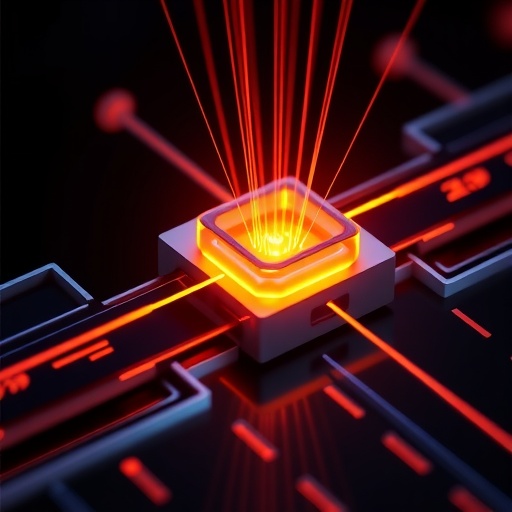In a groundbreaking development within the field of terahertz technology, researchers are harnessing the capabilities of Schottky barrier diodes to generate terahertz radiation. These devices stand out for their high power output and their suitability for integration into all-solid-state systems, presenting a promising avenue for advancements in various applications, from telecommunications to imaging technologies. However, as the researchers have discovered, the power output of individual diodes is often constrained by their inherent power handling capacity, which poses significant challenges for scaling up their effectiveness in high-frequency applications.
The utilization of a connected chain of Schottky barrier diodes has emerged as an effective strategy to surmount these limitations. By employing a power combining approach within these chains, researchers can potentially amplify the terahertz output power. Yet, a notable complication arises from the uneven electromagnetic field distribution among the diodes in the chain. This unevenness correlates directly with the terahertz wavelength being on par with the physical dimensions of the diodes, which not only hampers efficiency but also increases the risk of premature breakdown under high power conditions.
To address these significant challenges, the research team has designed an innovative asymmetric double-layer C-shaped diode chain structure. This unique configuration represents a pivotal advancement in controlling the local electromagnetic field distribution among the diodes. By optimizing this distribution, the researchers have successfully enhanced the conversion efficiency of the diode chain, thereby unlocking the potential for increased power output without compromising device integrity.
The results of this innovative design have been impressive, showcasing a frequency doubling efficiency of 38%. This milestone is particularly noteworthy as it is complemented by an output exceeding 300 mW at a frequency of 170 GHz, a feat that underscores both the ingenuity of the researchers and the potential applications of terahertz technology in real-world scenarios. The ability to achieve such high levels of output and efficiency positions this technology as a frontrunner in the quest for reliable terahertz sources.
As applications of terahertz radiation continue to expand, particularly in fields like medical imaging, security screening, and wireless communications, the demand for robust and efficient terahertz sources increases correspondingly. The findings from this research introduce a viable pathway to meet these growing demands. The development of the asymmetric double-layer C-shaped diode chain not only enhances the feasibility of producing high-power terahertz radiation but also opens the door for further innovations in diode technology.
Moreover, this innovation could significantly impact various industries by providing a means to generate terahertz waves with improved efficiency and reliability. The pursuit of increased output power from Schottky barrier diodes is essential, and this work represents a significant step forward in that direction. As the technology matures, it could lead to the creation of compact, efficient, and powerful terahertz sources that integrate seamlessly into existing technologies.
The implications of this research extend beyond mere enhancements in power output; they also suggest promising directions for future studies and developments in semiconductor design. The careful manipulation of diode structures to optimize electromagnetic field distribution represents a critical insight that could influence the next wave of innovations in the field of optoelectronics. By continuing to explore asymmetric designs, researchers could further improve efficiency and power handling in other electronic applications as well.
As the scientific community reflects on these developments, it becomes increasingly clear that the intersection of materials science, electrical engineering, and innovative design is paving the way for incredibly powerful and efficient terahertz technologies. Future research efforts will undoubtedly build on this foundation, exploring not just enhancements in power output but also investigating how these devices can be applied across various domains, further solidifying the significance of terahertz radiation in modern technology.
In summary, the work conducted by Zhou and colleagues presents a landmark achievement in the design and efficiency of terahertz radiation sources. The implementation of an asymmetric double-layer diode configuration elevates the potential of Schottky barrier diodes and demonstrates an effective approach to overcoming traditional barriers to high output power in these devices. As research continues to evolve in this field, it is likely that this innovative structure will inspire further advancements and applications that leverage the unique properties of terahertz waves for various technological purposes.
As the research team anticipates the practical applications of their findings, they also recognize the potential for collaboration across interdisciplinary fields, aiming to explore how their advancements can integrate with other technologies. This collaborative spirit is crucial for driving forward the state-of-the-art in terahertz technology and ensures that the benefits of this research reach the broader scientific community and its applications.
In conclusion, the creation of an asymmetric double-layer C-shaped diode chain that enhances terahertz power output reflects a paradigm shift in the design philosophy of Schottky barrier diodes. As researchers continue to refine and develop this technology, the foundations laid by this work are poised to inspire future innovations, facilitating clearer, faster communication and more advanced imaging techniques that will shape the future of technology.
Subject of Research: Terahertz radiation generation using Schottky barrier diodes
Article Title: A terahertz nonlinear diode chain based on an asymmetric double-layer topology
Article References:
Zhou, H., Zhou, T., Zhang, Y. et al. A terahertz nonlinear diode chain based on an asymmetric double-layer topology.
Nat Electron (2025). https://doi.org/10.1038/s41928-025-01460-9
Image Credits: AI Generated
DOI:
Keywords: terahertz, Schottky barrier diodes, asymmetric design, power output, electromagnetic fields.




